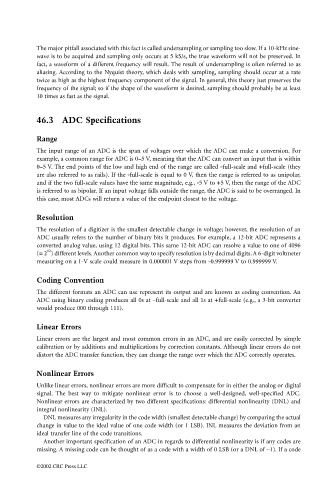Page 1186 - The Mechatronics Handbook
P. 1186
The major pitfall associated with this fact is called undersampling or sampling too slow. If a 10-kHz sine-
wave is to be acquired and sampling only occurs at 5 kS/s, the true waveform will not be preserved. In
fact, a waveform of a different frequency will result. The result of undersampling is often referred to as
aliasing. According to the Nyquist theory, which deals with sampling, sampling should occur at a rate
twice as high as the highest frequency component of the signal. In general, this theory just preserves the
frequency of the signal; so if the shape of the waveform is desired, sampling should probably be at least
10 times as fast as the signal.
46.3 ADC Specifications
Range
The input range of an ADC is the span of voltages over which the ADC can make a conversion. For
example, a common range for ADC is 0–5 V, meaning that the ADC can convert an input that is within
0–5 V. The end points of the low and high end of the range are called -full-scale and +full-scale (they
are also referred to as rails). If the -full-scale is equal to 0 V, then the range is referred to as unipolar,
and if the two full-scale values have the same magnitude, e.g., -5 V to +5 V, then the range of the ADC
is referred to as bipolar. If an input voltage falls outside the range, the ADC is said to be overranged. In
this case, most ADCs will return a value of the endpoint closest to the voltage.
Resolution
The resolution of a digitizer is the smallest detectable change in voltage; however, the resolution of an
ADC usually refers to the number of binary bits it produces. For example, a 12-bit ADC represents a
converted analog value, using 12 digital bits. This same 12-bit ADC can resolve a value to one of 4096
12
(= 2 ) different levels. Another common way to specify resolution is by decimal digits. A 6-digit voltmeter
measuring on a 1-V scale could measure in 0.000001 V steps from -0.999999 V to 0.999999 V.
Coding Convention
The different formats an ADC can use represent its output and are known as coding convention. An
ADC using binary coding produces all 0s at –full-scale and all 1s at +full-scale (e.g., a 3-bit converter
would produce 000 through 111).
Linear Errors
Linear errors are the largest and most common errors in an ADC, and are easily corrected by simple
calibration or by additions and multiplications by correction constants. Although linear errors do not
distort the ADC transfer function, they can change the range over which the ADC correctly operates.
Nonlinear Errors
Unlike linear errors, nonlinear errors are more difficult to compensate for in either the analog or digital
signal. The best way to mitigate nonlinear error is to choose a well-designed, well-specified ADC.
Nonlinear errors are characterized by two different specifications: differential nonlinearity (DNL) and
integral nonlinearity (INL).
DNL measures any irregularity in the code width (smallest detectable change) by comparing the actual
change in value to the ideal value of one code width (or 1 LSB). INL measures the deviation from an
ideal transfer line of the code transitions.
Another important specification of an ADC in regards to differential nonlinearity is if any codes are
missing. A missing code can be thought of as a code with a width of 0 LSB (or a DNL of –1). If a code
©2002 CRC Press LLC

